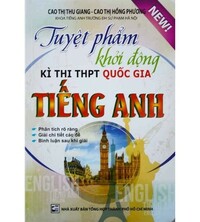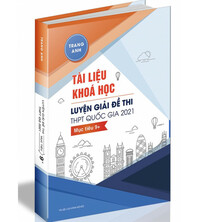Đề thi thử THPT Quốc gia môn Tiếng Anh
Đề thi thử THPT Quốc gia môn Tiếng Anh trường THPT Châu Thành 1, Đồng Tháp năm 2015 gồm 64 câu hỏi trắc nghiệm và 5 câu hỏi tự luận cùng phần thi viết có đáp án đi kèm, đây là tài liệu ôn tập môn Tiếng Anh hữu ích dành cho các bạn học sinh lớp 12 và những bạn chuẩn bị thi THPT Quốc gia, mời các bạn tham khảo.
Đề thi thử môn Anh THPT Quốc gia trực tuyến năm 2016 (Giải thích chi tiết Key)
Đề thi thử THPT Quốc gia môn Tiếng Anh online trường THPT Ngô Sĩ Liên, Bắc Giang năm 2016
Đề thi thử THPT Quốc gia môn Tiếng Anh trường THPT Tân Phú Trung, Đồng Tháp năm 2015
ĐỀ THI THỬ THPT QUỐC GIA NĂM 2015
ĐƠN VỊ: THPT CHÂU THÀNH 1
Mark the letter A, B, C, or D on your answer sheet to indicate the correct answer to each of the following questions.
Question 1: Hardly had the car turned round the corner when one of the back wheels ______.
A. broke away B. turned out C. came off D. rolled down
Question 2: Did you apologise to Beth, ______?
A. who you spilt some coffee on her dress
B. you spilt some coffee on her dress
C. whose dress you spilt some coffee
D. whose dress you spilt some coffee on
Question 3: ______ often serve as places of public entertainment and festivals, they can also be places where people can find peace.
A. Even though city parks B. City parks which
C. There are city parks which D. City parks are
Question 4: "Today's my 18th birthday" – "______."
A.Take care B. Have a good time
C. Many happy returns D. Oh, the older, the sadder
Question 5: The man ______ his invaluable time to redecorating the walls before the coming festival.
A. spent B. devoted C. used D. confessed
Question 6: Scientists and engineers have invented devices to remove ______ from industrial wastes.
A. pollutions B. pollute C. polluting D. pollutants
Question 7: Brian is going to see the principal because this is ______.
A. a such serious matter B. such serious matter
C. so serious a matter D. so serious matter
Question 8: Throughout history, the moon has inspired not only song and dance ______.
A. and also poetry and prose B. but poetry also prose
C. together with poetry and prose D. but poetry and prose as well
Question 9: It was very difficult for his Literature teacher to ______ what he has written.
A. make off B. make of C. make up D. make out
Question 10: ______ I dislike Hollywood films but this was an exception.
A. As a result B. As far as I know C. As a rule D. As soon as
Question 11: I was just looking in the shop window when this necklace ______ my eye.
A. drew B. appealed C. caught D. attracted
Question 12: In most ______ developed countries, up to 50% of ______ population enters higher education at some time in their lives.
A. the/ θ B. / θ C. the/ a D. θ /the
Question 13: My teacher was angry with me. I didn't do all the work I ______ last week.
A. need to have done B. may have done
C. should have done D. must have done
Question 14: In the primary school, a child is in the ______ simple setting.
A. comparison B. comparative C. comparatively D. comparable
Question 15: Hardly can we imagine how people rushed to see the first films ______ in the 1930s.
A. to be shown B. to show C. be shown D. showing
Question 16: The boss left instructions, under no circumstances ______ unattended.
A. should leave the office B. we are to leave the office
C. is the office to be left D. should the office leave
Question 17: "Oh no, I'm late for my appointment." – "______."
A. Catch you later B. Catch you now
C. Please to meet you D. Nice to see you
Question 18: His application was ______ because he is inexperienced and under-qualified.
A. turned on B. turned out C. turned in D. turned down
Question 19: When Peter was a child, there ______ a market near his house.
A. used to be B. used to have C. used to be being D. used to have been
Mark the letter A, B, C, or D on your answer sheet to indicate the word that differs from the rest in the position of the main stress in each of the following questions.
Question 20: A. advisable B. admirable C. admissible D. desirable
Question 21: A. automatic B. industrial C. occasional D. exaggerate
Question 22: A. continuous B. extinctive C. particular D. primitive
Mark the letter A, B, C, or D on your answer sheet to indicate the word whose underlined part is pronounced differently from that of the rest in each of the following questions.
Question 23: A. degree B. critical C. fertile D. minimun
Question 24: A. university B. understand C. discussion D. industrial
Mark the letter A, B, C, or D on your answer sheet to show the underlined part that needs correction in each of the following questions.
Question 25: Despite the terrible traffic, foreign visitors keep coming to the tourist attraction in
A B C
large amounts.
D
Question 26: Silver is too soft to use by itself, so it is mixed with another metal to make
A B C
themselves harder.
D
Question 27: The brain is made up of billions of neurons that differ with each other
A B C
in size and shape
D
Question 28: The bridge was hitting by a large ship during a sudden storm last week.
A B C D
Questions 29: Mary and her sister just bought two new winters coats at the clearance sale
A B C D
Mark the letter A, B, C, or D on your answer sheet to indicate the word or phrase that is CLOSEST in meaning to the underlined part in each of the following questions.
Question 30: Changing the departure time would have entailed getting up two hours earlier.
A. resulted from B. led to C. came out D. brought in
Question 31: The current economic crisis should be regarded as a warning not to be overconfident in the market.
A. depression B. inflation C. redundancy D. shortage
Question 32: He was sacked on the spot because he showed his shortage of the basic knowledge.
A. enrolled B. recalled C. dismissed D. relieved
Mark the letter A, B, C, or D on your answer sheet to indicate the word or phrase that is OPPOSITE in meaning to the underlined part in each of the following questions.
Question 33: He is interested in voluntary activities designed by Youth Union Organization.
A. obligatory B. desired C. ambitious D. willing
Question 34: Candidates can leave out insignificant information to avoid being confused when reading the instructions.
A. reasonable B. believable C. intentional D. major
Read the following passage and mark the letter A, B, C, or D on your answer sheet to indicate the correct answer to each of the questions from 35 to 44.
Butterflies are among the most extensively studied insects – an estimated 90 percent of the world's species have scientific names. As a consequence, they are perhaps the best group of insects for examining patterns of terrestrial biotic diversity and distribution. Butterflies also have a favorable image with the general public. Hence, they are an excellent group for communicating information on science and conservation issues such as diversity.
Perhaps the aspect of butterfly diversity that has received the most attention over the past century is the striking difference in species richness between tropical and temperate regions.
For example, in 1875, one biologist pointed out the diversity of butterflies in the Amazon when he mentioned that about 700 species were found within an hour's walk, whereas the total number found on the British islands did not exceed 66, and the whole of Europe supported only 321. This early comparison of tropical and temperate butterfly richness has been well confirmed.
A general theory of diversity would have to predict not only this difference between temperate and tropical zones, but also patterns within each region, and how these patterns vary among different animal and plant groups. However, for butterflies, variation of species richness within temperate and tropical regions is poorly understood. Indeed, comparisons of numbers of species among the Amazon basin, tropical Asia, and Africa are still mostly "personal communication" citations, even for vertebrates. In other words, unlike comparison temperate and tropical areas, these patterns are still in the documentation phase.
In documenting geographical variation in butterfly diversity, some arbitrary, practical decisions are made. Diversity, number of species, and species richness are used synonymously; little is known about the evenness of butterfly distribution. The New World butterflies make up the preponderance of examples because they are the most familiar species. It is hoped that by focusing on them, the errors generated by imperfect and incomplete taxonomy will be minimized.
Question 35. The word "consequence" in paragraph 1 is closest in meaning to.
A. result B. explanation C. analysis D. requirement
Question 36. The word "striking" in paragraph 2 is closest in meaning to.
A. physical B. confusing C. noticeable D. successful
Question 37. Butterflies are a good example for communicating information about conservation issues because they.
A. are simple in structure B. have been given scientific names
C. are viewed positively by people D. are found mainly in temperate climates.
Question 38. The word "exceed" in paragraph 3 is closest in meaning to.
A. locate B. allow C. go beyond D. come close to
Question 39. What is the most distinguishing feature of butterfly diversity in the past century?
A. Numerous patterns of terrestrial biotic diversity and distribution.
B. Comparisons of behavior patterns of butterflies and certain animal groups.
C. The striking difference in species richness between tropical and temperate regions.
D. The documentation phase of the process.
Question 40. Which of the following is NOT well understood by biologists?
A. European butterfly habitats.
B. Differences in species richness between temperate and tropical regions.
C. Differences in species richness within a temperate or a tropical region.
D. Comparisons of behavior patterns of butterflies and certain animal groups.
Question 41. All of the following are mentioned as being important parts of a general theory of diversity EXCEPT.
A. differences between temperate and tropical zones.
B. patterns of distribution of species in each region.
C. migration among temperate and tropical zones.
D. variation of patterns of distribution of species among different animal and plants.
Question 42. Which aspect of butterflies does the passage mainly discuss?
A. Their physical characteristics.
B. Their adaptation to different habitats
C. Their names
D. Their variety
Question 43. The author mentions "tropical Asia" in paragraph 3 as an example of a location where.
A. butterfly behavior varies with climate
B. a general theory of butterfly diversity has not yet been firmly established
C. butterflies are affected by human populations
D. documenting plant species is more difficult than documenting butterfly species
Question 44. The word "generated" in paragraph 5 is closest in meaning to.
A. requested B. caused C. assisted D. estimated
Read the following passage and mark the letter A, B, C, or D on your answer sheet to indicate the correct answer to each of the questions from 45 to 54
For more than six million American children, coming home after school means coming back to an empty house. Some deal with the situation by watching TV. Some may hide. But all of them have something in common. They spend part of each day alone. They are called "latchkey children". They are children who look after themselves while their parents work. And their bad condition has become a subject of concern.
Lynette Long was once the principal of an elementary school. She said, "we had a school rule against wearing jewelry. A lot of kids had chains around their necks with keys attached. I was constantly telling them to put the keys inside shirts. There were so many keys; it never came to my mind what they meant." Slowly, she learned that they were house keys.
She and her husband began talking to the children who had keys. They learned of the effect working couples and single parents were having on their children. Fear wasthe biggest problem faced by children at home alone. One in three latchkey children the Longs talked to reported being frightened. Many had nightmares and were worried about their own safety.
The most common way latchkey children deal with their fears is by hiding. They may hide in a shower stall, under a bed or in a closet. The second is TV. They often turn the volume up. It's hard to get statistics on latchkey children, the Longs have learned. Most parents are slow to admit that they leave their children alone.
Question 45. The phrase "an empty house" in the passage mostly means.
A. a house with too much space
B. a house with no furniture
C. a house with no people inside
D. a house with nothing inside
Question 46. One thing that the children in the passage share is that.
A. they all wear jewelry
B. they spend part of each day alone
C. they all watch TV
D. they are from single-parent families
Question 47. The phrase "latchkey children" in the passage means children who.
A. like to carry latches and keys with them everywhere
B. close doors with keys and watch TV by themselves
C. look after themselves while their parents are not at home
D. are locked inside houses with latches and keys
Question 48. The main problem of latchkey children is that they.
A. are growing in numbers
B. watch too much television during the day
C. are also found in middle-class families
D. suffer a lot from being left alone
Question 49. What is the main idea of the first paragraph?
A. Why kids hate going home
B. Children's activities at home
C. Bad condition of latchkey children
D. How kids spend free time
Question 50. Why did a lot of kids have chains around their necks with keys attached?
A. They were fully grown and had become independent.
B. They had to use the keys to open school doors.
C. Schools didn't allow them to wear jewelry, so they wore keys instead.
D. They would use the keys to enter their houses when they came home.
Question 51. What do latchkey children suffer most from when they are at home alone?
A. Tiredness B. Boredom C. Loneliness D. Fear
Question 52. Lynette Long learned of latchkey children's problems by.
A. visiting their homes B. talking to them
C. delivering questionaires D. interviewing their parents
Question 53. What is the most common way for latchkey children to deal with fears?
A. Talking to the Longs B. Having a shower
C. Hiding somewhere D. Lying under a TV
Question 54. It's difficult to find out the number of latchkey children because.
A. there are too many of them in the whole country
B. most parents are reluctant to admit that they leave their children alone
C. they hide themselves in shower stalls or under beds
D. they do not give information about themselves for safety reasons
Read the following passage and mark the letter A, B, C, or D on your answer sheet to indicate the correct word for each of the blanks from 55 to 64.
Set in the red desert of the central Australia in the mining town of the Coober Pedy. At first sight, the town looks similar to many other such communities, but Coober Pedy is different. Sixty percent of its population is some 4,000 people living underground. There are today about 800 underground houses as well as shops, hotels and even churches in the town and the (55) _______ hills. Once a site has been chosen, special tunneling machines are (56) _________ in to create passages and rooms in the sandstone. Rock pillars are left to (57) _______ the roof, and doors and windows are cut into the front. Houses are of all shapes and (58) ________, the largest has twenty rooms, and some even have their own swimming pool.
Living underground may sound strange but in fact it has a number of advantages. In summer, the temperature outside can reach an astonishing 47 degrees Celsius, and in winter the night can be (59) ________ cold. However, inside the house it remains a steady 25 degrees Celsius all year (60) ________. Many people say that living underground makes them feel very secure. There is no problem with noise from the neighbors and the houses are not (61) ________ by the fierce dust storms that regularly (62) _________ through the area. And of course, if your family (63) _________ or lots of friends come to stay, you can (64) _________ dig another room.
Question 55. A. near B. enclosing C. close D. surrounding
Question 56. A. brought B. entered C. placed D. worked
Question 57. A. lift B. support C. push D. rise
Question 58. A. sizes B. areas C. volumes D. numbers
Question 59. A. strongly B. heavily C. extremely D. sharply
Question 60. A. along B. round C. across D. wide
Question 61. A. spoiled B. disturbed C. influenced D. affected
Question 62. A. pour B. sweep C. flood D. hurry
Question 63. A. grows B. rises C. stretches D. explodes
Question 64. A. only B. always C. regularly D. ever
WRITING
Part I. Finish each of the following sentences in such a way that it means the same as the sentence printed before it.
Question 65: Trang didn't know how to solve the problem so she got poor marks
If ......................................................................................................................
Question 66: She started loving him 2 years ago
She fell ............................................................................................................
Question 67: The boy is too young to understand the problem
The boy isn't ....................................................................................................
Question 68: No student in my class can run as fast as Jack
Jack is .............................................................................................................
Question 69: The children like to walk in the rain
The children enjoy ...........................................................................................
Part II. In about 120 words, write a paragraph to describe a popular celebration in Vietnam that you like best.
Đáp án đề thi thử THPT Quốc gia môn Tiếng Anh
| 1. C 2. D 3. A 4. C 5. B 6. D 7. C 8. D | 9. D 10. C 11. C 12. D 13. C 14. C 15. A 16. C | 17. A 18. D 19. A 20. B 21. A 22. D 23. C 24. A | 25. D 26. D 27. C 28. A 29. C 30. B 31. A 32. C | 33. A 34. D 35. A 36. C 37. C 38. C 39. A 40. B | 41. C 42. D 43. B 44. B 45. C 46. B 47. C 48. D | 49. C 50. D 51. D 52. B 53. C 54. B 55. D 56. A | 57. B 58. A 59. C 60. B 61. D 62. B 63. A 64. B |
WRITING
65. If Trang had known how to solve the problem, she wouldn't have got poor marks
66. She fell in love with him 2 years ago
67. The boy isn't old enough to understand the problem
68. Jack is the fastest runner in my class
69. The children enjoy walking in the rain







